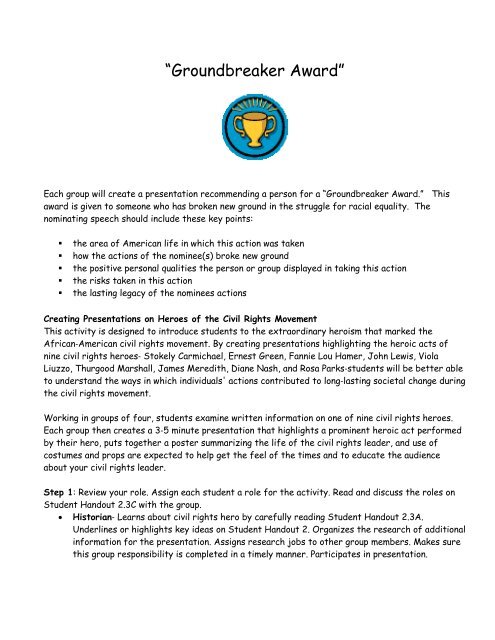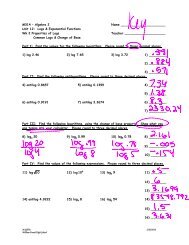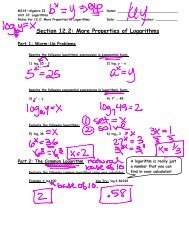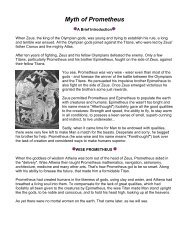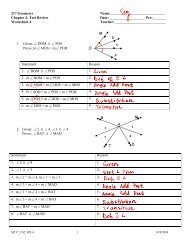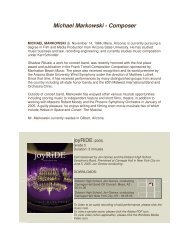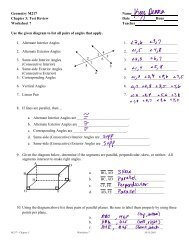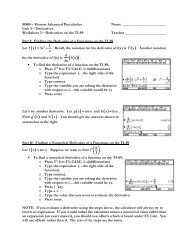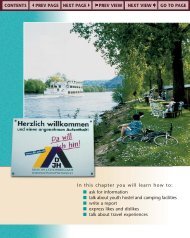Heros in the Civil Rights - William Fremd High School
Heros in the Civil Rights - William Fremd High School
Heros in the Civil Rights - William Fremd High School
You also want an ePaper? Increase the reach of your titles
YUMPU automatically turns print PDFs into web optimized ePapers that Google loves.
“Groundbreaker Award”<br />
Each group will create a presentation recommend<strong>in</strong>g a person for a “Groundbreaker Award.” This<br />
award is given to someone who has broken new ground <strong>in</strong> <strong>the</strong> struggle for racial equality. The<br />
nom<strong>in</strong>at<strong>in</strong>g speech should <strong>in</strong>clude <strong>the</strong>se key po<strong>in</strong>ts:<br />
<strong>the</strong> area of American life <strong>in</strong> which this action was taken<br />
how <strong>the</strong> actions of <strong>the</strong> nom<strong>in</strong>ee(s) broke new ground<br />
<strong>the</strong> positive personal qualities <strong>the</strong> person or group displayed <strong>in</strong> tak<strong>in</strong>g this action<br />
<strong>the</strong> risks taken <strong>in</strong> this action<br />
<strong>the</strong> last<strong>in</strong>g legacy of <strong>the</strong> nom<strong>in</strong>ees actions<br />
Creat<strong>in</strong>g Presentations on Heroes of <strong>the</strong> <strong>Civil</strong> <strong>Rights</strong> Movement<br />
This activity is designed to <strong>in</strong>troduce students to <strong>the</strong> extraord<strong>in</strong>ary heroism that marked <strong>the</strong><br />
African-American civil rights movement. By creat<strong>in</strong>g presentations highlight<strong>in</strong>g <strong>the</strong> heroic acts of<br />
n<strong>in</strong>e civil rights heroes- Stokely Carmichael, Ernest Green, Fannie Lou Hamer, John Lewis, Viola<br />
Liuzzo, Thurgood Marshall, James Meredith, Diane Nash, and Rosa Parks-students will be better able<br />
to understand <strong>the</strong> ways <strong>in</strong> which <strong>in</strong>dividuals' actions contributed to long-last<strong>in</strong>g societal change dur<strong>in</strong>g<br />
<strong>the</strong> civil rights movement.<br />
Work<strong>in</strong>g <strong>in</strong> groups of four, students exam<strong>in</strong>e written <strong>in</strong>formation on one of n<strong>in</strong>e civil rights heroes.<br />
Each group <strong>the</strong>n creates a 3-5 m<strong>in</strong>ute presentation that highlights a prom<strong>in</strong>ent heroic act performed<br />
by <strong>the</strong>ir hero, puts toge<strong>the</strong>r a poster summariz<strong>in</strong>g <strong>the</strong> life of <strong>the</strong> civil rights leader, and use of<br />
costumes and props are expected to help get <strong>the</strong> feel of <strong>the</strong> times and to educate <strong>the</strong> audience<br />
about your civil rights leader.<br />
Step 1: Review your role. Assign each student a role for <strong>the</strong> activity. Read and discuss <strong>the</strong> roles on<br />
Student Handout 2.3C with <strong>the</strong> group.<br />
• Historian- Learns about civil rights hero by carefully read<strong>in</strong>g Student Handout 2.3A.<br />
Underl<strong>in</strong>es or highlights key ideas on Student Handout 2. Organizes <strong>the</strong> research of additional<br />
<strong>in</strong>formation for <strong>the</strong> presentation. Assigns research jobs to o<strong>the</strong>r group members. Makes sure<br />
this group responsibility is completed <strong>in</strong> a timely manner. Participates <strong>in</strong> presentation.
• Presentation Manager-In charge of organization of presentation. Makes sure <strong>the</strong> presentation<br />
is created <strong>in</strong> such a way that it allows <strong>the</strong> audience to learn about <strong>the</strong> civil rights leader and<br />
<strong>the</strong>ir heroic act/acts. Additionally, must make sure <strong>the</strong> presentation does not go over <strong>the</strong> 5<br />
m<strong>in</strong>ute time limit. Participates <strong>in</strong> presentation.<br />
• Graphics Manager-Responsible for ga<strong>the</strong>r<strong>in</strong>g all visual <strong>in</strong>formation for <strong>the</strong> presentation.<br />
Helps put toge<strong>the</strong>r <strong>the</strong> poster for presentation. Participates <strong>in</strong> presentation.<br />
• Poster Manager –Responsible for organiz<strong>in</strong>g all <strong>in</strong>formation and visuals on <strong>the</strong> poster. Makes<br />
sure all aspects of <strong>the</strong> poster are present and done <strong>in</strong> a timely manner. Assigns research for<br />
additional <strong>in</strong>formation and visuals to <strong>the</strong> responsible group members if necessary.<br />
Step 2: Learn about your civil rights hero. Read <strong>the</strong> <strong>in</strong>formation on Student Handout 2.3A. Have<br />
Historians highlight or under l<strong>in</strong>e key ideas about <strong>the</strong> hero and his or her actions dur<strong>in</strong>g <strong>the</strong> civil<br />
rights movement. Ga<strong>the</strong>r additional <strong>in</strong>formation on <strong>the</strong>ir civil rights hero from outside sources.<br />
Groups should have a thorough understand<strong>in</strong>g of <strong>the</strong>ir hero's actions dur<strong>in</strong>g <strong>the</strong> civil<br />
rights movement.<br />
Step 3: Bra<strong>in</strong>storm ideas for your presentation and poster. Your group must create <strong>the</strong> presentation<br />
and poster highlight<strong>in</strong>g a prom<strong>in</strong>ent heroic act performed by <strong>the</strong>ir hero dur<strong>in</strong>g <strong>the</strong> civil rights<br />
movement. To do so, <strong>the</strong>y should determ<strong>in</strong>e what is <strong>the</strong> most prom<strong>in</strong>ent heroic act from Student<br />
Handout 2.3A? This should <strong>the</strong>n become <strong>the</strong> ma<strong>in</strong> po<strong>in</strong>t of <strong>the</strong> presentation and poster.<br />
Step 4: Write up your presentation and <strong>in</strong>formation for your poster. Organize <strong>the</strong> presentation to<br />
convey your civil rights leaders’ background, civil rights history, heroic act, and significance of <strong>the</strong>ir<br />
work. Beg<strong>in</strong> to rehearse your presentation. Make sure not to go over 5 m<strong>in</strong>utes.<br />
Step 5: Organize your poster. Incorporate written <strong>in</strong>formation and visuals <strong>in</strong> an appeal<strong>in</strong>g and<br />
creative way.
Information on Stokely Carmichael<br />
Student Handout •<br />
Stokely Carmichael was one of <strong>the</strong> most<br />
outspoken leaders of <strong>the</strong> civil rights<br />
movement dur<strong>in</strong>g <strong>the</strong> 1960s. Carmichael<br />
was born <strong>in</strong> 1941 and raised on <strong>the</strong><br />
Caribbean island of Tr<strong>in</strong>idad. When he<br />
was 11 years old, his family immigrated to<br />
<strong>the</strong> United States and settled on <strong>the</strong> East<br />
Coast. Stokely was an <strong>in</strong>telligent young<br />
man, and <strong>in</strong> his teens he set out to become<br />
a medical doctor. Though he ga<strong>in</strong>ed<br />
admission to prestigious Harvard<br />
University, he chose <strong>in</strong>stead to attend<br />
Howard University, an all-black and<br />
politically active college <strong>in</strong> Wash<strong>in</strong>gton DC. It was <strong>the</strong>re that he began his <strong>in</strong>volvement <strong>in</strong><br />
<strong>the</strong> <strong>Civil</strong>-<strong>Rights</strong> Movement, jo<strong>in</strong><strong>in</strong>g sit-<strong>in</strong> demonstrations and freedom rides with <strong>the</strong> Student<br />
Nonviolent Coord<strong>in</strong>at<strong>in</strong>g Committee, or SNCC (pronounced "snick"). As a result of his<br />
activism, Carmichael was beaten by whites, imprisoned <strong>in</strong> cold jail cells, and shocked with<br />
;--- electric cattle prods.<br />
• Where did Carmichael grow up?<br />
• In what way did he become <strong>in</strong>volved with civil rights?<br />
Despite this harsh treatment, Carmichael was undeterred from his aim to help African<br />
Americans achieve civil rights. Start<strong>in</strong>g <strong>in</strong> 1964, he focused his efforts on organiz<strong>in</strong>g black<br />
communities to ga<strong>in</strong> <strong>in</strong>creased political power through voter registration. Carmichael began<br />
his campaign <strong>in</strong> Lowndes County, Alabama-perhaps <strong>the</strong> most racist and dangerous county<br />
<strong>in</strong> <strong>the</strong> state. He founded <strong>the</strong> Lowndes County Freedom Organization to assist Mrican<br />
Americans <strong>in</strong> pass<strong>in</strong>g voter registration tests. With<strong>in</strong> one year, <strong>the</strong> percentage of black voters<br />
<strong>in</strong>creased from 0 to 46 percent.<br />
As <strong>the</strong> 1960s wore on, Carmichael became <strong>in</strong>creas<strong>in</strong>gly conv<strong>in</strong>ced that moderate civil rights<br />
leaders were <strong>in</strong>effective, and that <strong>the</strong>y made too many compromises to achieve civil rights<br />
advances. He began to advocate <strong>in</strong>creased militancy (vigorous support for a cause) from<br />
Mrican Americans, po<strong>in</strong>t<strong>in</strong>g out that sou<strong>the</strong>rn politicians did little to prosecute racists<br />
<strong>in</strong>volved <strong>in</strong> lynch<strong>in</strong>g and bomb<strong>in</strong>gs. Carmichael's persistence and anger at <strong>in</strong>justice were an<br />
<strong>in</strong>spiration to many blacks who had been terrorized by white police brutality and <strong>the</strong> Ku<br />
Klux Klan. Under Carmichael's leadership, some blacks armed <strong>the</strong>mselves for self-defense<br />
and guarded <strong>the</strong>ir churches aga<strong>in</strong>st nighttime mob attacks. They agreed with Carmichael that<br />
<strong>the</strong> freedom struggle needed to move beyond a strictly nonviolent stance and consider selfdefense<br />
an appropriate response to racist attacks.<br />
© Teachers' Curriculum Institute USH-12-S, Activity 2.3, Page 9
Student Handout •<br />
• How did Carmichael help blacks <strong>in</strong> Lowndes County, Alabama?<br />
• What did Carmichael suggest blacks do <strong>in</strong> <strong>the</strong> face of violence?<br />
Carmichael also wanted to free <strong>the</strong> African-American civil rights movement from<br />
dependence on whites. He felt that whites' <strong>in</strong>volvement <strong>in</strong> <strong>the</strong> movement created <strong>the</strong><br />
impression that blacks could not help <strong>the</strong>mselves. On June 17, 1966, dur<strong>in</strong>g a 200-mile<br />
March Aga<strong>in</strong>st Fear across <strong>the</strong> state of Mississippi, Carmichael delivered a stirr<strong>in</strong>g speech<br />
that encouraged African Americans to take power <strong>in</strong>to <strong>the</strong>ir own hands. On <strong>the</strong> eleventh day<br />
of <strong>the</strong> march, <strong>the</strong> 600 marchers stopped <strong>in</strong> Greenwood and tried to set up tents for <strong>the</strong> night<br />
on <strong>the</strong> grounds of a local black school. Carmichael was arrested for trespass<strong>in</strong>g and jailed for<br />
six hours with two o<strong>the</strong>r SNCC workers. The night after he was released, <strong>the</strong> marchers held a<br />
rally. Most of <strong>the</strong> speakers spoke to <strong>the</strong> crowd about <strong>the</strong> power of peaceful demonstrations to<br />
show that blacks deserved civil rights. Carmichael, <strong>the</strong> last speaker, had a different message.<br />
"This is <strong>the</strong> twenty-seventh time I have been arrested," he said angrily. "I a<strong>in</strong>'t go<strong>in</strong>g to jail<br />
no more." He noted that blacks had been ask<strong>in</strong>g for "freedom now" for six years, but had<br />
gotten noth<strong>in</strong>g. His anger ris<strong>in</strong>g, he said, "Every courthouse <strong>in</strong> Mississippi should be burnt<br />
down tOlyorrow so we can get rid of this dirt. From now on when <strong>the</strong>y ask you what you<br />
want, you know what to tell 'em. We want Black Power!" The people shouted back, "Black<br />
Power!" aga<strong>in</strong> and aga<strong>in</strong>, resolv<strong>in</strong>g to no longer be afraid to demand justice.<br />
• What did most civil rights speakers tell <strong>the</strong> marchers <strong>in</strong> Greenwood?<br />
• What was Carmichael's message to <strong>the</strong> marchers <strong>in</strong> Greenwood?<br />
Many blacks eagerly used <strong>the</strong> phrase "Black Power" dur<strong>in</strong>g <strong>the</strong> rema<strong>in</strong>der of <strong>the</strong> March<br />
Aga<strong>in</strong>st Fear and took it home to <strong>the</strong>ir communities. The black power movement helped<br />
change <strong>the</strong> emphasis of <strong>the</strong> civil rights movement, and lent an angrier tone to civil rights<br />
demonstrations. In addition to giv<strong>in</strong>g blacks courage, Carmichael's words stirred <strong>the</strong>ir pride<br />
<strong>in</strong> <strong>the</strong>ir African heritage. African Americans began to call for greater emphasis on black<br />
history and <strong>the</strong> establishment of Afro-American studies at universities.<br />
The "Black Power" slogan that Stokely Carmichael popularized created controversy both<br />
with<strong>in</strong> and outside <strong>the</strong> civil rights movement. Many civil rights leaders felt that <strong>the</strong> slogan<br />
would end <strong>the</strong> era of nonviolent protests, cause needless kill<strong>in</strong>g, and alienate white allies.<br />
Indeed, many whites feared Carmichael's militancy. The FBI <strong>in</strong>vestigated and blamed<br />
Carmichael for creat<strong>in</strong>g <strong>the</strong> m<strong>in</strong>d-set that resulted <strong>in</strong> widespread race riots <strong>in</strong> <strong>the</strong> late 1960s.<br />
Despite <strong>the</strong> strident tone of <strong>the</strong> black power movement, however, <strong>the</strong> positive impact of<br />
Carmichael's efforts is undeniable. His passion and charismatic leadership <strong>in</strong>spired o<strong>the</strong>rs<br />
to work <strong>in</strong> <strong>the</strong>ir communities to build bus<strong>in</strong>esses, to start schools where black history was<br />
celebrated, and to develop community-based programs to feed and clo<strong>the</strong> <strong>the</strong> poor.<br />
• How did "black power" impact <strong>the</strong> black community?<br />
• What were <strong>the</strong> criticisms of black power?<br />
• What were achievements of black power?<br />
© Teachers' Curriculum Institute USH-12-S, Activity 2.3, Page 10
Information on Ernest Green<br />
Student Handout •<br />
At only 16 years of age, Ernest Green<br />
became a leader of <strong>the</strong> civil rights<br />
movement by bravely <strong>in</strong>itiat<strong>in</strong>g <strong>the</strong><br />
desegregation of Sou<strong>the</strong>rn schools.<br />
Born <strong>in</strong> 1941 and raised <strong>in</strong> Little Rock,<br />
Arkansas, Green had attended all-black,<br />
segregated schools all his life. These<br />
schools typically had outdated textbooks,<br />
<strong>in</strong>adequate supplies and facilities, and<br />
poor fund<strong>in</strong>g. Green was an ambitious<br />
student, and <strong>in</strong> 1957, when he was a<br />
high school junior, he made a dramatic<br />
decision. He decided to leave most of his<br />
friends at <strong>the</strong> all-black high school and enroll at all-white Central <strong>High</strong> <strong>School</strong> for his senior<br />
year. He wanted a better education for himself and to pave <strong>the</strong> way for future generations of<br />
black children to attend <strong>the</strong> best schools available. Eight o<strong>the</strong>r black students jo<strong>in</strong>ed Green <strong>in</strong><br />
<strong>in</strong>tegration efforts at Central <strong>High</strong>. They came to be known as <strong>the</strong> "Little Rock N<strong>in</strong>e."<br />
Most whites <strong>in</strong> Little Rock strongly opposed <strong>in</strong>tegration. Arkansas governor Orval Faubus,<br />
m<strong>in</strong>dful of voter op<strong>in</strong>ion <strong>in</strong> an election year, sent National Guardsmen to <strong>the</strong> school grounds<br />
to prevent <strong>the</strong> Little Rock N<strong>in</strong>e from enter<strong>in</strong>g <strong>the</strong> school. Town mobs encircled <strong>the</strong> n<strong>in</strong>e<br />
black students, and state guardsmen blocked <strong>the</strong>ir paths with bayonets. In addition,<br />
segregationists such as <strong>the</strong> Mo<strong>the</strong>rs League and <strong>the</strong> White Citizens Councils telephoned<br />
Green and o<strong>the</strong>r families with midnight death threats. F<strong>in</strong>ally, President Dwight Eisenhower<br />
took action to protect <strong>the</strong> students' rights, order<strong>in</strong>g 1,000 paratroopers to escort <strong>the</strong> students<br />
onto campus, where <strong>the</strong>y successfully enrolled.<br />
• What year did Ernest Green enroll at Central <strong>High</strong> <strong>School</strong>? Why did<br />
he want to enroll <strong>the</strong>re?<br />
• Who were <strong>the</strong> Little Rock N<strong>in</strong>e?<br />
• Were <strong>the</strong> Little Rock N<strong>in</strong>e successful?<br />
Despite <strong>the</strong> protection of <strong>the</strong> federal troops, <strong>the</strong> Little Rock N<strong>in</strong>e were cont<strong>in</strong>ual targets<br />
of white students' hatred. Throughout <strong>the</strong> school year, Green suffered numerous acts of<br />
discrim<strong>in</strong>ation. For example, he regularly had racial slurs directed at him <strong>in</strong> hallways. In <strong>the</strong><br />
gym shower room, white boys flung steam<strong>in</strong>g hot towels <strong>in</strong> his face, and even placed broken<br />
glass <strong>in</strong> <strong>the</strong> shower so that he cut his feet. Still, Green rema<strong>in</strong>ed committed to <strong>the</strong> cause.<br />
When <strong>the</strong> Little Rock N<strong>in</strong>e met toge<strong>the</strong>r dur<strong>in</strong>g afternoons, Green, <strong>the</strong> eldest and only senior<br />
among <strong>the</strong> group, comforted his younger classmates, often us<strong>in</strong>g humor to distract <strong>the</strong>m.<br />
© Teachers' Curriculum Institute USH-12-5, Activity 2.3, Page 11
Information on Fannie Lou Hamer<br />
Student Handout •<br />
Fannie Lou Townsend Hamer, <strong>the</strong><br />
granddaughter of a slave, was a passionate<br />
crusader aga<strong>in</strong>st poverty and racism<br />
dur<strong>in</strong>g <strong>the</strong> civil rights movement. Born <strong>in</strong><br />
1917 <strong>in</strong> Ruleville, Mississippi, to a family<br />
of sharecroppers, Hamer was youngest of<br />
20 children. Her hardwork<strong>in</strong>g fa<strong>the</strong>r saved<br />
money to raise <strong>the</strong> family's standard of<br />
liv<strong>in</strong>g, only to lose it when a jealous white<br />
neighbor poisoned <strong>the</strong> family's mules and<br />
cows. Hamer worked daily <strong>in</strong> <strong>the</strong> fields<br />
with her family, attend<strong>in</strong>g school for only<br />
six years. In her forties, she married, and<br />
discovered she could not bear children of<br />
her own. Upset, she learned she had been <strong>in</strong>voluntarily sterilized dur<strong>in</strong>g an operation by a<br />
white Sou<strong>the</strong>rn doctor-similar to hundreds of operations that were performed on o<strong>the</strong>r poor<br />
black women-that was supposedly to remove a tumor. She and her husband raised two<br />
foster daughters.<br />
• Where did Fannie Lou Hamer grow up?<br />
• What acts of discrim<strong>in</strong>ation did she and her family face?<br />
Despite <strong>the</strong> difficulties she faced, Hamer held a firm faith <strong>in</strong> God and a determ<strong>in</strong>ation to<br />
assist o<strong>the</strong>rs and help br<strong>in</strong>g an end to racial discrim<strong>in</strong>ation. She became active <strong>in</strong> politics,<br />
and was one of <strong>the</strong> first blacks <strong>in</strong> Ruleville to register to vote (harassment, beat<strong>in</strong>gs, and<br />
special tests discouraged blacks from register<strong>in</strong>g). Hamer <strong>the</strong>n helped o<strong>the</strong>rs pass registration<br />
tests and eventually became a full-time fieldworker <strong>in</strong> <strong>the</strong> civil rights movement. As a result<br />
of her activism, <strong>the</strong> plantation owner on whose farm she lived evicted her and her family <strong>in</strong><br />
1962. Still, Hamer was undeterred. She went on to run for congressional office and helped to<br />
register over 63,000 African Americans to vote. She was also <strong>in</strong>strumental <strong>in</strong> found<strong>in</strong>g <strong>the</strong><br />
biracial Mississippi Freedom Democratic Party (MFDP) <strong>in</strong> 1964, which presented a<br />
legitimate challenge and alternative to <strong>the</strong> white-controlled Democratic Party <strong>in</strong> Mississippi.<br />
In addition to her political efforts, Hamer worked to improve her community. She helped get<br />
federal support for early childhood education, started a Freedom Farm Cooperative to<br />
improve profits for sharecropp<strong>in</strong>g farmers, raised money for low-cost hous<strong>in</strong>g, and brought<br />
jobs to Ruleville by help<strong>in</strong>g br<strong>in</strong>g <strong>in</strong> a garment factory.<br />
• How did Hamer become <strong>in</strong>volved <strong>in</strong> <strong>the</strong> civil rights movement?<br />
• What were her key political successes?<br />
• In what o<strong>the</strong>r ways did she help her community?<br />
© Teachers' Curriculum Institute USH-12-5, Activity 2.3, Page 13
Information on John Lewis<br />
Student Handout •<br />
John Lewis jo<strong>in</strong>ed <strong>the</strong> front l<strong>in</strong>es of<br />
<strong>the</strong> civil rights movement <strong>in</strong> his early<br />
twenties. Lewis was born <strong>in</strong> 1940 and<br />
raised with a strict and serious faith by<br />
sharecropper parents <strong>in</strong> poor Pike County,<br />
Alabama. A Christian preacher-<strong>in</strong>tra<strong>in</strong><strong>in</strong>g,<br />
John delivered his first sermons<br />
at <strong>the</strong> age of five to <strong>the</strong> 60 chickens<br />
owned by his family. Mer high school,<br />
he enrolled <strong>in</strong> <strong>the</strong> American Baptist<br />
Theological Sem<strong>in</strong>ary for tra<strong>in</strong><strong>in</strong>g.<br />
However, his <strong>in</strong>terest <strong>in</strong> <strong>the</strong> civil<br />
rights movement's public "Christian<br />
conscience" soon outweighed his <strong>in</strong>terest<br />
<strong>in</strong> private religion, and he eagerly got <strong>in</strong>volved. Lewis jo<strong>in</strong>ed <strong>the</strong> sit-<strong>in</strong> demonstrations <strong>in</strong><br />
1960, stay<strong>in</strong>g up nights to draft tra<strong>in</strong><strong>in</strong>g memos on <strong>the</strong> "dos and don'ts" of nonviolent<br />
protest. He soon became a student leader, demonstrat<strong>in</strong>g for o<strong>the</strong>rs how to sit straight at<br />
./-- lunch counters dur<strong>in</strong>g desegregation attempts, and how to strictly refra<strong>in</strong> from curs<strong>in</strong>g,<br />
laugh<strong>in</strong>g, convers<strong>in</strong>g, or strik<strong>in</strong>g back at anyone. Lewis <strong>the</strong>n embarked on <strong>the</strong> 1961 Freedom<br />
Rides to desegregate <strong>the</strong> bus system, fac<strong>in</strong>g repeated arrests and bloody beat<strong>in</strong>gs by white<br />
segregationists at <strong>in</strong>terstate bus term<strong>in</strong>als.<br />
• Where did John Lewis grow up?<br />
• Why did he jo<strong>in</strong> <strong>the</strong> civil rights movement?<br />
• What demonstrations did he participate <strong>in</strong>?<br />
Lewis was a passionate and powerful speaker. In August 1963, he spoke to 250,000<br />
Americans assembled <strong>in</strong> Wash<strong>in</strong>gton DC dur<strong>in</strong>g <strong>the</strong> March on Wash<strong>in</strong>gton. By <strong>the</strong>n he was<br />
23 years old and had been jailed 20 times. Lewis had prepared an angry speech criticiz<strong>in</strong>g<br />
President Kennedy's adm<strong>in</strong>istration for its lack of attention to <strong>the</strong> civil rights cause. Though<br />
he was persuaded by more moderate civil rights leaders to tone down his address, he spoke<br />
out boldly for better pay, protection from police brutality, and vot<strong>in</strong>g rights. That year, Lewis<br />
became <strong>the</strong> chairman of <strong>the</strong> Student Nonviolent Coord<strong>in</strong>at<strong>in</strong>g Committee, or SNCC<br />
(pronounced "snick"), an organization devoted to organiz<strong>in</strong>g rural black communities. Lewis<br />
dedicated himself to marches and voter registration drives <strong>in</strong> <strong>the</strong> most segregated towns <strong>in</strong><br />
<strong>the</strong> Deep South, subject<strong>in</strong>g himself to arrests, attacks, and life threats.<br />
• What did Lewis do dur<strong>in</strong>g <strong>the</strong> March on Wash<strong>in</strong>gton?<br />
• How many times had Lewis been jailed by <strong>the</strong> time he was 23?<br />
• What organization did Lewis become leader or?<br />
© Teachers' Curriculum Institute USH-12-5, Activity 2.3, Page 15
Student Handout B<br />
Lewis demonstrated his absolute commitment to black freedom and nonviolence dur<strong>in</strong>g a<br />
notable march from Selma to Montgomery, Alabama. On Sunday, March 7, 1965, 600 people<br />
ga<strong>the</strong>red <strong>in</strong> Selma to protest <strong>the</strong> beat<strong>in</strong>g and kill<strong>in</strong>g of African-American Jimmie Lee<br />
Jackson by a white state trooper. They planned a 50-mile journey that was to end <strong>in</strong> a protest<br />
demonstration at segregationist governor George Wallace's capitol build<strong>in</strong>g. SNCC did not<br />
support Lewis's participation <strong>in</strong> <strong>the</strong> march, so he jo<strong>in</strong>ed as an <strong>in</strong>dividual freedom fighter with<br />
his backpack filled with an apple, two books, and a toothbrush. When Mart<strong>in</strong> Lu<strong>the</strong>r K<strong>in</strong>g Jr.<br />
decided not to lead <strong>the</strong> march, Lewis stepped up to <strong>the</strong> front with ano<strong>the</strong>r civil rights worker,<br />
Hosea <strong>William</strong>s. The two leaders led <strong>the</strong> column of marchers, solemnly s<strong>in</strong>g<strong>in</strong>g freedom<br />
songs from downtown Selma, through black neighborhoods, and up <strong>the</strong> rise of <strong>the</strong> Edmund<br />
Pettis Bridge just outside town.<br />
When <strong>the</strong>y reached <strong>the</strong> crest of <strong>the</strong> bridge, <strong>the</strong> marchers stopped as <strong>the</strong>y saw row after row<br />
of uniformed state troopers carry<strong>in</strong>g clubs, whips, and gas masks. "Can you swim?" Hosea<br />
<strong>William</strong>s wryly asked Lewis, after which <strong>the</strong> men led <strong>the</strong> marchers down <strong>the</strong> bridge. Over<br />
<strong>the</strong> bullhorn, <strong>the</strong> state troopers blared "This is an unlawful assembly ... not conducive to<br />
public safety," and <strong>the</strong>n ordered <strong>the</strong> marchers to return home with<strong>in</strong> two m<strong>in</strong>utes. One<br />
m<strong>in</strong>ute later, <strong>the</strong> rows of troopers advanced. In what became known as "Bloody Sunday,"<br />
<strong>the</strong>y first attacked John Lewis, clubb<strong>in</strong>g him on <strong>the</strong> left side of his head and fractur<strong>in</strong>g his<br />
skull. They <strong>the</strong>n turned on <strong>the</strong> o<strong>the</strong>r marchers, beat<strong>in</strong>g <strong>the</strong>m and spray<strong>in</strong>g tear gas to force<br />
<strong>the</strong>m to retreat. Amaz<strong>in</strong>gly, Lewis got up, stumbled back over <strong>the</strong> bridge amidst toxic teargas<br />
clouds, assisted o<strong>the</strong>r victims, and delivered a short speech before allow<strong>in</strong>g himself to be<br />
admitted to <strong>the</strong> Good Samaritan Hospital.<br />
Lewis's beat<strong>in</strong>g on <strong>the</strong> Edmund Pettis Bridge was televised to a shocked nation. 1\vo days<br />
later, Lewis rejo<strong>in</strong>ed an enlarged group of protesters, declar<strong>in</strong>g "Next time we march ... we<br />
may have to go on to Wash<strong>in</strong>gton." By month's end, <strong>the</strong> march from Selma to Montgomery<br />
had grown from a few hundred to over 25,000 marchers, <strong>in</strong>clud<strong>in</strong>g Mart<strong>in</strong> Lu<strong>the</strong>r K<strong>in</strong>g Jr.<br />
Shortly <strong>the</strong>reafter, Congress passed <strong>the</strong> Vot<strong>in</strong>g <strong>Rights</strong> Act of 1965, designed to protect <strong>the</strong><br />
vot<strong>in</strong>g rights of blacks throughout <strong>the</strong> South.<br />
• Why did Lewis and o<strong>the</strong>rs set out to march from Selma to<br />
Montgomery, Alabama?<br />
• What happened to Lewis and <strong>the</strong> marchers on Edmund Pettis Bridge?<br />
• What happened to <strong>the</strong> march after it was stopped by police?<br />
© Teachers' Curriculum Institute USH-12-5, Activity 2.3, Page 16
Student Handout e<br />
at last with joyous freedom songs and speeches. Liuzzo stayed afterward to shuttle<br />
passengers back to Selma <strong>in</strong> her car, despite o<strong>the</strong>rs urg<strong>in</strong>g her to rest. She was driv<strong>in</strong>g<br />
19-year-old Leroy Moton, a black civil rights worker, back through Lowndes County around<br />
7 :30 that even<strong>in</strong>g when she noticed a car pull up alongside <strong>the</strong>m. The four occupants of that<br />
car, one an FBI <strong>in</strong>formant and all members of <strong>the</strong> Ku Klux Klan, noticed she was a white<br />
woman and he a black man. They began to chase Liuzzo and Moton, who sped up to 90<br />
miles per hour on a now dark and empty <strong>High</strong>way 80. Twenty miles outside Selma near Big<br />
Swamp Creek, Liuzzo was humm<strong>in</strong>g <strong>the</strong> freedom song "We Shall Overcome" when one of<br />
<strong>the</strong> four men poked his gun out a w<strong>in</strong>dow and shot Liuzzo <strong>in</strong> <strong>the</strong> skull through her w<strong>in</strong>dow.<br />
She died <strong>in</strong>stantly, and Leroy Moton feigned (pretended) death as <strong>the</strong> KKK gunmen sent 11<br />
more bullets <strong>in</strong>to Liuzzo's car. F<strong>in</strong>ally, Moton crawled out of <strong>the</strong> car and hailed a civil rights<br />
truck driv<strong>in</strong>g by.<br />
• Why did Liuzzo jo<strong>in</strong> <strong>the</strong> civil rights movement?<br />
• How did Liuzzo die?<br />
• Why did people kill her?<br />
The news of Viola Liuzzo's death quickly reached her family, <strong>the</strong> president, and <strong>the</strong> nation.<br />
She was <strong>the</strong> first white woman martyred <strong>in</strong> <strong>the</strong> civil rights struggle, and some whites<br />
criticized her <strong>in</strong>volvement. They sent hate mail to her family, or criticized her past history of<br />
divorce. However, many Americans hailed Liuzzo as a hero<strong>in</strong>e and engraved her name on<br />
monuments at <strong>the</strong> site of her murder and <strong>in</strong> Detroit. Liuzzo's son followed <strong>in</strong> her footsteps,<br />
help<strong>in</strong>g register black voters and eventually becom<strong>in</strong>g a civil rights educator.<br />
• How did people respond to Liuzzo's death?<br />
© Teachers' Curriculum Institute USH-12-5, Activity 2.3, Page 18
Information on Thurgood Marshall<br />
Student Handout •<br />
Thurgood Marshall (far left <strong>in</strong> <strong>the</strong> picture)<br />
was a civil rights lawyer and U.S.<br />
Supreme Court justice who worked for<br />
civil rights from <strong>the</strong> 1930s until his<br />
retirement <strong>in</strong> 1991. Marshall was born <strong>in</strong><br />
1908 and was raised by two work<strong>in</strong>g<br />
parents <strong>in</strong> Baltimore, Maryland, and<br />
Harlem, New York, <strong>in</strong> a strongly<br />
segregated (racially separate)<br />
environment. From <strong>the</strong> time he was<br />
young, Marshall was encouraged by his<br />
fa<strong>the</strong>r to use <strong>the</strong> law to achieve justice for<br />
African Americans. <strong>William</strong> Marshall<br />
took Thurgood and his bro<strong>the</strong>r to hear<br />
court cases so that <strong>the</strong>y could learn <strong>the</strong> skills of legal argument. As a young student,<br />
Thurgood was assigned to read <strong>the</strong> Constitution as punishment for classroom mischief;<br />
however, he memorized it <strong>in</strong>stead. Marshall attended all-black L<strong>in</strong>coln University <strong>in</strong> Chester,<br />
Pennsylvania, and <strong>the</strong>n went on to get his law degree at Howard University <strong>in</strong> Wash<strong>in</strong>gton<br />
DC. He became so skilled <strong>in</strong> discuss<strong>in</strong>g <strong>the</strong> law that his university debate team called him<br />
"Wrathful Marshall."<br />
• Where did Marshall grow up?<br />
• What profession did he tra<strong>in</strong> for?<br />
In <strong>the</strong> 1930s, Marshall jo<strong>in</strong>ed <strong>the</strong> National Association for <strong>the</strong> Advancement of Colored<br />
People (NAACP), an organization that promoted African-American civil rights. Dur<strong>in</strong>g his<br />
tenure with <strong>the</strong> organization, Marshall fought many court cases for clients too poor to pay<br />
him. Without regard for money, he battled tirelessly to place blacks on juries, ga<strong>in</strong> equal pay<br />
for African-American teachers, and enlist black pilots for World War II. From <strong>the</strong> 1940s to<br />
<strong>the</strong> 1960s, Marshall played a critical role <strong>in</strong> w<strong>in</strong>n<strong>in</strong>g almost every major civil rights case.<br />
One of <strong>the</strong> most important cases he contributed to was <strong>the</strong> landmark 1954 Brown v. Board<br />
of Education case, <strong>in</strong> which <strong>the</strong> Supreme Court ruled that school segregation was<br />
unconstitutional. With his flawless logic, dignified aura, and straightforward speech,<br />
Marshall won 29 of <strong>the</strong> 32 cases he argued before <strong>the</strong> Supreme Court. President Lyndon B.<br />
Johnson appo<strong>in</strong>ted him as one of n<strong>in</strong>e Supreme Court justices <strong>in</strong> 1967, bestow<strong>in</strong>g on him <strong>the</strong><br />
highest honor for a lawyer <strong>in</strong> <strong>the</strong> country.<br />
© Teachers' Curriculum Institute USH-12-5, Activity 2.3, Page 19
Student Handout •<br />
• What did Marshall do for <strong>the</strong> NAACP?<br />
• What was <strong>the</strong> Brown v. Board 0/ Education case?<br />
• How many Supreme Court cases did Marshall w<strong>in</strong> and lose?<br />
• What did <strong>the</strong> president of <strong>the</strong> United States appo<strong>in</strong>t him to do <strong>in</strong> 1967?<br />
Throughout his life, Thurgood Marshall faced threats of death and violence from sou<strong>the</strong>rn<br />
whites who opposed his fight for racial equality. One such <strong>in</strong>cident occurred <strong>in</strong> 1946, several<br />
months after Marshall had won <strong>the</strong> acquittal of 24 out of 25 black defendants <strong>in</strong> a case<br />
<strong>in</strong>volv<strong>in</strong>g <strong>in</strong>terracial violence. One night <strong>in</strong> 1946, Marshall was driv<strong>in</strong>g to Nashville,<br />
Tennessee, with two o<strong>the</strong>r NAACP lawyers, Z. Alexander Looby and Maurice Weaver. As<br />
<strong>the</strong>y passed through Columbia, Tennessee, a group of eight white city police, state troopers,<br />
and sheriffs followed and stopped Marshall's car, tell<strong>in</strong>g <strong>the</strong> lawyers <strong>the</strong>y had a warrant to<br />
search <strong>the</strong> car for illegal alcohol. The officers conducted <strong>the</strong> search and found noth<strong>in</strong>g. They<br />
let <strong>the</strong> three men go, but stopped <strong>the</strong>m aga<strong>in</strong> one mile down <strong>the</strong> road. This time, <strong>the</strong> police<br />
grabbed Marshall, accused him of driv<strong>in</strong>g <strong>in</strong>toxicated, and told <strong>the</strong> o<strong>the</strong>r two lawyers to<br />
leave. The police drove Marshall toward <strong>the</strong> Duck River, where members of <strong>the</strong> Ku Klux<br />
Klan were wait<strong>in</strong>g with a noose to lynch him. However, Looby and Weaver ga<strong>the</strong>red<br />
a group of armed black residents and followed <strong>the</strong> police car. The police were thus forced<br />
to drive <strong>in</strong>stead to <strong>the</strong> local magistrate's office <strong>in</strong> town, where Marshall blew his breath<br />
forcefully <strong>in</strong>to <strong>the</strong> official's face to prove his sobriety.<br />
Despite several more threats to his life, Marshall's success <strong>in</strong> w<strong>in</strong>n<strong>in</strong>g civil rights cases<br />
cont<strong>in</strong>ued to grow. From 1967 to 1991, he served faithfully on <strong>the</strong> Supreme Court. Dur<strong>in</strong>g<br />
his tenure, he presided over hundreds of court cases, and sought to make <strong>the</strong> Constitution a<br />
truly "liv<strong>in</strong>g document" to support justice for all races.<br />
• What happened to Marshall as he was driv<strong>in</strong>g to Nashville?<br />
• What prevented him from be<strong>in</strong>g lynched?<br />
• What did Marshall do between 1967 and 1991?<br />
© Teachers' Curriculum Institute USH-12-5, Activity 2.3, Page 20
I nformation on James Meredith<br />
Student Handout •<br />
James Meredith's <strong>in</strong>dividual acts of<br />
courage brought him great admiration<br />
dur<strong>in</strong>g <strong>the</strong> civil rights movement.<br />
Meredith was born <strong>in</strong> 1933 and grew up<br />
<strong>in</strong> <strong>the</strong> impoverished and segregated<br />
(racially separate) town of Kosciusko,<br />
Mississippi. There he experienced many<br />
'forms of segregation and <strong>in</strong>equality, from<br />
<strong>the</strong> local restaurant where food was served<br />
over different counters for whites and<br />
blacks, to segregated schools. Meredith<br />
was angered by segregation and<br />
determ<strong>in</strong>ed to take action to try to change<br />
it. However, ra<strong>the</strong>r than seek<strong>in</strong>g a leadership position <strong>in</strong> an organized civil rights group, he<br />
took <strong>in</strong>dividual action to combat discrim<strong>in</strong>ation.<br />
• Where did James Meredith grow up?<br />
• What acts of discrim<strong>in</strong>ation did he face?<br />
In 1961, Meredith decided to become <strong>the</strong> first black to enroll at <strong>the</strong> University of<br />
Mississippi. He attempted to register <strong>in</strong> <strong>the</strong> fall, but was met by hostile white mobs of more<br />
than 2,000 people. It was only after 18 months of legal delays and riots that Meredith, with<br />
<strong>the</strong> protection of federal troops, won his suit and began his college career. Dur<strong>in</strong>g <strong>the</strong> 1950s,<br />
Meredith developed a successful career as a U.S. Air Force officer. Dur<strong>in</strong>g <strong>the</strong> 1960s, he<br />
earned a law degree from Columbia University, and he ran for Congress <strong>in</strong> 1972. However,<br />
Meredith chose active participation <strong>in</strong> <strong>the</strong> black freedom struggle over a life of comfort and<br />
security. Over and over aga<strong>in</strong>, he risked his life to achieve justice and equality for African<br />
Americans.<br />
• What did Meredith do <strong>in</strong> 1961?<br />
• What happened when he tried to register for classes at <strong>the</strong> University<br />
of Mississippi?<br />
• How long did it take before he was able to attend <strong>the</strong> university? Why<br />
did it take this long?<br />
One <strong>in</strong>cident <strong>in</strong> particular demonstrates James Meredith's <strong>in</strong>credible strength and courage.<br />
On June 5, 1966, Meredith set off alone to march 200 miles from Memphis, Tennessee, to<br />
r-- Jackson, Mississippi. He was determ<strong>in</strong>ed to cross most of <strong>the</strong> state of Mississippi to prove<br />
that white sou<strong>the</strong>rn dom<strong>in</strong>ance was pass<strong>in</strong>g and that blacks could now vote and walk <strong>in</strong><br />
public without fear of racial violence. O<strong>the</strong>rs <strong>in</strong>volved <strong>in</strong> <strong>the</strong> civil rights movement opposed<br />
© Teachers' Curriculum Institute USH-12-5, Activity 2.3, Page 21
Information on Diane Nash<br />
Student Handout •<br />
Diane Nash's enthusiasm and<br />
uncompromis<strong>in</strong>g militancy (vigorous support<br />
of a cause) made her a formidable civil rights<br />
worker. Nash (second from right <strong>in</strong> <strong>the</strong><br />
picture) was born <strong>in</strong> 1938 and grew up a<br />
devout Catholic <strong>in</strong> Chicago, Ill<strong>in</strong>ois, and<br />
moved south <strong>in</strong> <strong>the</strong> late 1950s. Once <strong>the</strong>re,<br />
Nash realized <strong>the</strong> grossly harmful effects<br />
segregation (racial separation) had on both<br />
blacks and whites. She was offended by<br />
restaurant owners tell<strong>in</strong>g her to "Go around to<br />
<strong>the</strong> back door where you belong." Nash decided to devote her life to <strong>the</strong> struggle for Mrican<br />
American civil rights.<br />
Nash's early <strong>in</strong>volvement <strong>in</strong> <strong>the</strong> civil rights movement began when she was a student at Fisk<br />
University. She became <strong>in</strong>volved <strong>in</strong> a sit-<strong>in</strong> demonstration at a whites-only lunch counter <strong>in</strong><br />
Nashville, Tennessee, <strong>in</strong> 1959. She enthusiastically organized and participated <strong>in</strong> <strong>the</strong> sit-<strong>in</strong><br />
movement throughout <strong>the</strong> 1960s. She and leaders such as John Lewis helped start <strong>the</strong><br />
Student Nonviolent Coord<strong>in</strong>at<strong>in</strong>g Committee, or SNCC (pronounced "snick"), which led<br />
protests aga<strong>in</strong>st segregation across <strong>the</strong> South. Nashville's student protesters, under Nash's<br />
leadership, learned how to dress, talk, and respond nonviolently to police and mob brutality.<br />
They quickly became <strong>the</strong> largest and most discipl<strong>in</strong>ed group of <strong>the</strong> black student protest<br />
movement of <strong>the</strong> 1960s. In fact, Nash became so well-known that sou<strong>the</strong>rn court officials<br />
often asked defendants, "Do you know Diane Nash?" when try<strong>in</strong>g to determ<strong>in</strong>e <strong>the</strong>ir level of<br />
<strong>in</strong>volvement <strong>in</strong> <strong>the</strong> civil rights movement.<br />
• Why did Diane Nash devote her life to <strong>the</strong> African-American struggle<br />
for civil rights?<br />
• Bow did she and her followers protest segregation?<br />
• Bow successful was Nash's leadership of student protesters?<br />
Nash <strong>in</strong>spired o<strong>the</strong>rs not to compromise <strong>the</strong>ir fight for justice. At times she criticized civil<br />
rights leaders for seek<strong>in</strong>g political recognition over genu<strong>in</strong>e improvement for African<br />
Americans. She taught o<strong>the</strong>rs go to jail, ra<strong>the</strong>r than cooperate with <strong>the</strong> system by pay<strong>in</strong>g<br />
what she deemed "guilty" bail f<strong>in</strong>es. She readily applied her "jail, no bail" motto to herself,<br />
even go<strong>in</strong>g to prison when four months pregnant. With her gift of articulate speech and her<br />
model behavior, Nash <strong>in</strong>spired o<strong>the</strong>rs to will<strong>in</strong>gly give up <strong>the</strong>ir personal comforts and even<br />
<strong>the</strong>ir lives for racial justice. For example, when violence threatened to stop <strong>the</strong> freedom<br />
rides--demonstrations to desegregate <strong>in</strong>terstate buses and bus term<strong>in</strong>als-Nash worked<br />
© Teachers' Curriculum Institute USH-12-5, Activity 2.3, Page 23
Student Handout E<br />
@Teachers' Curriculum Institute USH-12-5, Activity 2.3, Page 40


